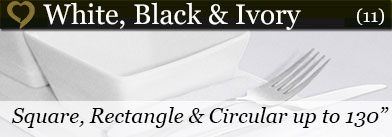Tablecloths Washing Guide - Washing, Ironing & Stain Removal

Ideal for Hospitality, Hotels, Restaurants, Healthcare, and the Home.
The tablecloths are absorbent, soft and durable with a texture ‘Cotton Feel’ touch.
"Love Tablecloths" polyester tablecloths are strong, durable with low colour loss and minimal shrinkage. Made with 100% polyester vortex air spun textured, blended, and twisted yarns. The tablecloths are woven, dyed and finished on state-of-the-art machinery, given reinforced hems and high-quality stitching to protect the longevity of the tablecloths.
Reduced energy consumption requirements & faster processing time in laundering, longer product lifetime cycle, giving a substantial cost saving compared to cotton tablecloths.
Quick Overview
Wash at 40 - 50°C maximum temperature with a biological detergent - Do not overload the washing machine - short spin cycle - Hang dry or tumble dry on the lowest heat setting until damp - medium temperature iron setting with steam.
How To Wash & Look After Your Polyester Tablecloths
Before you start to wash your tablecloths, please read the following guidelines.
Always sort different shades of tablecloths into white, coloured light, medium and dark shades for separate washing loads to avoid cross staining.
Do not mix with different fabric/fibre types. Washing or drying with 100% cotton and polyester/cotton blends with 100% polyester tablecloths will result in cotton lint attaching to the surface of the polyester fabric giving the appearance of pilling (or “bobbling)
Shake out the tablecloths to remove any cutlery, solid food residues and other foreign objects before loading into the washing machine. Items such as knives and pens can permanently stain and damage the fabric. The machinery may also be subject to damage.
It is very important the polyester tablecloths & napkins are washed at temperature no higher than 50°C with a short spin cycle setting 800-1000 maximum rpm.
High temperatures above 50°C washing and drying, without a sufficient cool down stage will result in Thermal Shock Creasing. This occurs when hot, soft, and pliable polyester fibres are cooled too quickly whilst in a crumpled state. This results as “broken ice” wrinkles creases on the fabric surface. the creases will be permanent in the fabric and cannot be removed.
Load the washing machine 3/4 full of its drum capacity, this will allow the tablecloths extra movement increasing the effectiveness of the washing process and reduces creasing.
Biological detergents are highly recommended. When residual stains, especially fats and oils are not removed by the washing process and then ironed, these stains will be set into the fabric by the heat of ironing and become hard to remove. Biological detergents contain special enzymes which help break down the fats and oils in the washing cycle.
Do not overload the washing machine. The tablecloths must be able to move sufficiently in the washing machine, as it is the combined action of the water, detergent, and heat in the wash program cycle time that dissolve, lift and remove the stains from the tablecloths. Overloading the machine will give a poor washing result and leave residual stains in the tablecloths and can cause hard crease lines by crushing the fabric.
For residual staining, adding an oxygen based bleaching agent with the laundry detergent will assist the washing process. Care and attention should be given to the conditions of use. We recommend ‘Vanish Oxi Action’ or supermarket home brand equivalent product.
Detergents containing OBA (Optical Brightening Agents) are only recommended on white goods. This will make a white fabric appear whiter and brighter.
The use of detergents containing OBA can alter the appearance of some coloured shades giving the impression of colour loss. Coloured fabric should ideally be washed in detergents that do not contain OBA.
Chlorine bleach (Sodium Hypochlorite) will cause colour shade changes, permanent colour loss and fabric damage will occur. Chlorine bleach should be avoided, if required use a small quantity on white polyester shades only.
For Heavy Stained Items sponge down or wipe the stained areas with a small amount of undiluted biological detergent, then put the table linen in your washing machine with a full wash load dosage amount of biological detergent.
Set the machine temperature wash program setting to 40 - 50°C, switch on the washing machine and allow to run only for 10 minutes !!!!_ "THEN PRESS PAUSE" for the items to soak in the machine for 8 hours or overnight. Afterwards, unpause the washing machine and let it run through its full cycle.
Using a small amount of fabric softener in the final rinse stage will assist in removing static and creasing. Adding too much fabric conditioner, will create a build-up of a barrier affecting the absorbency, touch and feel of the tablecloths.
Adding a small amount of white vinegar in the final rinse stage will act as a disinfectant. The vinegar smell will disappear upon drying.
All tablecloths should be removed immediately from the washing machine when the wash program has finished, followed either with a short tumble dry on a low temperature setting or line dried. This may be available on washing machines as a Permanent-Press wash or Synthetics wash setting/program.
Use a low RPM spin cycle speed setting, this will avoid and minimize crushing of the fabric in the drum of the washing machine.
Polyester Tablecloths Dry Fast!!!!
Tumble drying - Do Not Over Dry and Check Continuously, dry on the lowest heat setting (if a damp moisture sensor setting is not available on the tumble drier) remove from the tumble dryer when slightly damp and immediately fold neatly to reduce ironing.
“We highly recommend loading the tumble dryer at less than 50% capacity. This provides the optimum conditions within the drum for the tablecloths to circulate & dry evenly.
Overloading the tumble dryer, especially with large tablecloths, may result in permanent creasing which cannot be corrected. (Overloading may cause the heating element to transfer heat via the surface of the drum, causing the tablecloth fibres to melt and in turn damage the fabric). We highly recommend therefore that large tablecloth sizes (in domestic environments) are line-dried then ironed whilst still damp.”
Line drying - Hang dry the tablecloths and they will be ready to iron within a few hours, as polyester hold less water than cotton after washing, this will make the tablecloths less creased before ironing.
Ironing is required. For best results polyester tablecloths should be ironed slightly damp. The action of the steam and pressure from the iron will make ironing faster and easier to remove the creasing. Start with the iron on the lowest heat setting that produces steam first and adjust the temperature of the iron slowly to find the optimum steam output.
When the heat setting is too high it may scorch or melt the fabric. Always check and test on a small area first to find the correct temperature setting of your iron. The use of fine water mist spray is also recommended.
Ver 1.15
Need any help on what is the correct size tablecloth you require?
Measure your table length & width, for square & rectangular tables
Measure your table top diameter for round tables
View our tablecloths size guide chart for white table cover requirements
For further assistance, please send a message or give us a call
'We Love To Talk' call us on Free Phone 0800 612 1379
(Sales Lines Open Monday-Friday 9:00am-5:00pm)

















